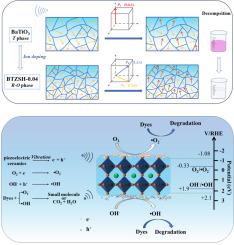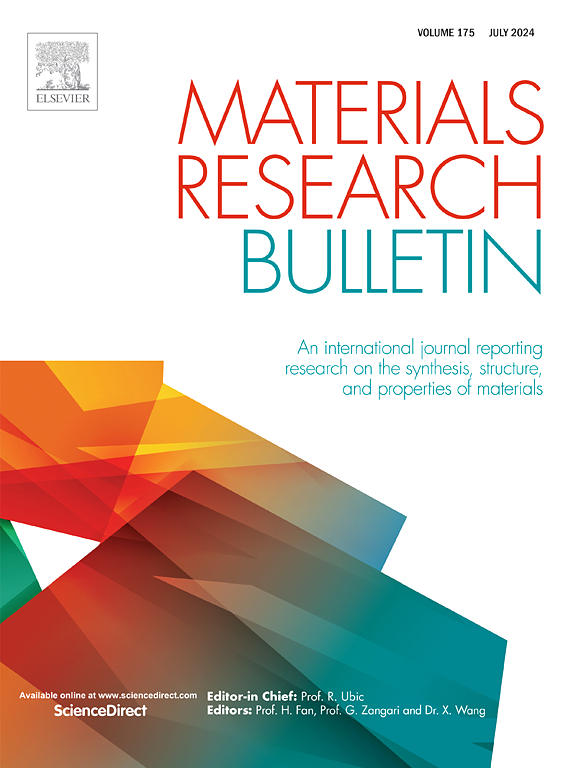Efficient enhancement of piezo-catalytic activity of BaTiO3-based piezoelectric ceramics via phase boundary engineering
IF 5.3
3区 材料科学
Q2 MATERIALS SCIENCE, MULTIDISCIPLINARY
引用次数: 0
Abstract
Piezoelectric catalysis stemmed from lead-free piezoelectric ceramics is an emerging catalytic technology applied extensively in degradation of organic pollutants due to its low energy consumption and non-pollution. However, the dissatisfied catalytic efficiency of lead-free piezoelectric ceramics has constrained their further development and application. Herein, we employ ion doping to modulate the phase boundary construction of BaTiO3-based piezoelectric ceramics (BaTi(1-x)(Zr1/3Sn1/3Hf1/3)xO3, BTZSH-x), and the degradation performances of organic dyes are explored to illuminate the piezo-catalytic mechanism. The ion doping alters the phase boundary of BaTiO3 ceramics and a two-phase coexistence of rhombohedral-orthorhombic is achieved at room temperature in BTZSH-0.04 ceramic. Consequently, the BTZSH-0.04 ceramic exhibits an excellent degradation efficiency of rhodamine B with 97.27% in 60min and a high reaction rate constant of 0.056 min−1 under ultrasonication which is 7.4 times more than that of pristine BaTiO3. This work provides an advisable policy for constructing environmental-friendly piezoelectric materials with glorious piezo-catalytic activity.

通过相界工程有效增强 BaTiO3 基压电陶瓷的压电催化活性
源于无铅压电陶瓷的压电催化技术是一种新兴的催化技术,因其能耗低、无污染而被广泛应用于有机污染物的降解。然而,无铅压电陶瓷的催化效率不尽如人意,制约了其进一步发展和应用。在此,我们采用离子掺杂的方法来调节 BaTiO3 基压电陶瓷(BaTi(1-x)(Zr1/3Sn1/3Hf1/3)xO3,BTZSH-x)的相界结构,并探索了有机染料的降解性能,从而阐明了压电催化机理。离子掺杂改变了 BaTiO3 陶瓷的相界,BTZSH-0.04 陶瓷在室温下实现了斜方体-正方体两相共存。因此,BTZSH-0.04 陶瓷在 60 分钟内对罗丹明 B 的降解效率高达 97.27%,在超声条件下的反应速率常数高达 0.056 min-1,是原始 BaTiO3 的 7.4 倍。这项工作为构建具有优异压电催化活性的环保型压电材料提供了可取的策略。
本文章由计算机程序翻译,如有差异,请以英文原文为准。
求助全文
约1分钟内获得全文
求助全文
来源期刊

Materials Research Bulletin
工程技术-材料科学:综合
CiteScore
9.80
自引率
5.60%
发文量
372
审稿时长
42 days
期刊介绍:
Materials Research Bulletin is an international journal reporting high-impact research on processing-structure-property relationships in functional materials and nanomaterials with interesting electronic, magnetic, optical, thermal, mechanical or catalytic properties. Papers purely on thermodynamics or theoretical calculations (e.g., density functional theory) do not fall within the scope of the journal unless they also demonstrate a clear link to physical properties. Topics covered include functional materials (e.g., dielectrics, pyroelectrics, piezoelectrics, ferroelectrics, relaxors, thermoelectrics, etc.); electrochemistry and solid-state ionics (e.g., photovoltaics, batteries, sensors, and fuel cells); nanomaterials, graphene, and nanocomposites; luminescence and photocatalysis; crystal-structure and defect-structure analysis; novel electronics; non-crystalline solids; flexible electronics; protein-material interactions; and polymeric ion-exchange membranes.
 求助内容:
求助内容: 应助结果提醒方式:
应助结果提醒方式:


